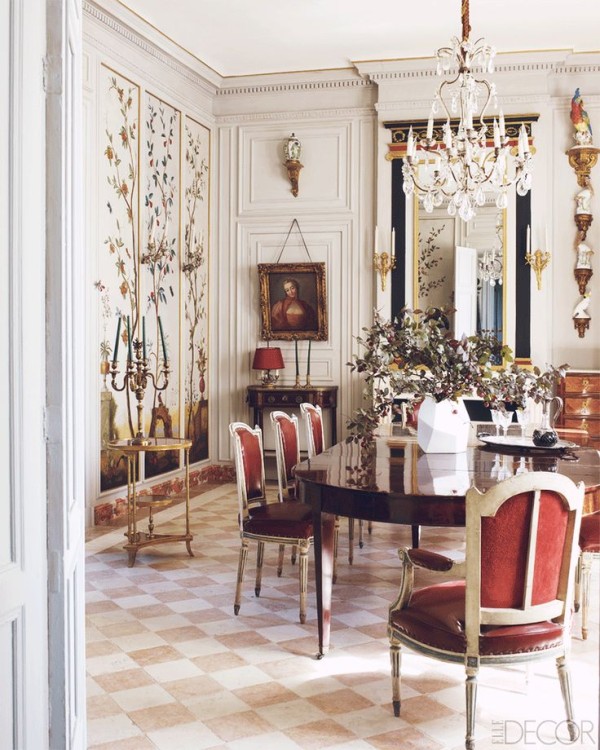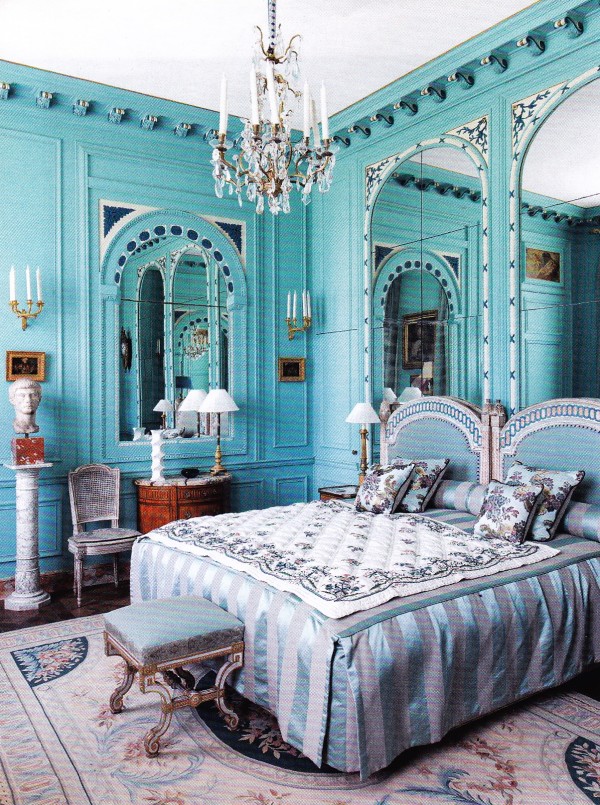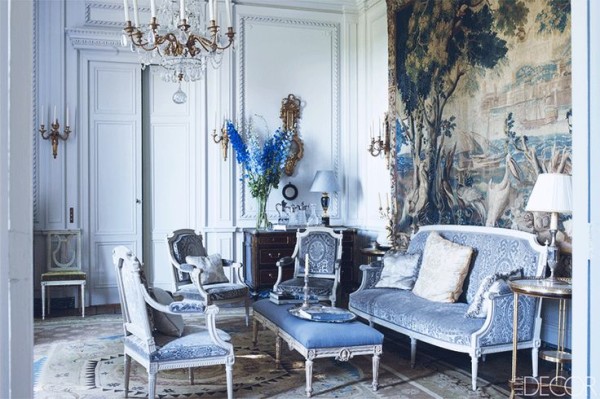Château Fourcas-Hosten is a dream of a wine estate with a fairy-tale ending. Located in the Listrac appellation in the Médoc region of Bordeaux, it was conceived by Jean-Baptiste Hosten, a lawyer, in the 18th-century, its 116 acres planted with grapevines for as far as the eye could see. It was eventually ceded to the Saint Affrique family by Hosten’s son, creating the brand Château Fourcas Hosten, bringing with it international renown. But centuries of neglect had diminished the chateau’s one-time magnificence, much of its interior decorative elements destroyed or missing. Enter two Prince Charmings, brothers Laurent and Renaud Momméja, both members of the Hermés luxury brand dynasty. In 2006 the brothers Momméja purchased the wine estate and brought in French interior designers Michael Coorengel and Jean-Pierre Calvagrac of Coorengel & Calvagrac to return it to a better version of its former glory. Elle Decor published the château’s refreshed interiors in 2013 but I discovered new photos of its room in the German edition of Architectural Digest and thought it would be interesting to revisit this remarkable property.
In this particular southwestern region of France such an estate is referred to as a chartreuse, typically a large stone house with a gently sloping tile roof accompanied by a large plot of land. In the case of Château Fourcas-Hosten the estate more closely resembles a villa, or a pavillon de plaisance, than a château. Other than for the second level above the entrance, all the main rooms exist en infilade. The first photo was taken from inside the entrance hall looking back toward the motor court and the 12th-century Romanesque church beyond.
Jean-Pierre Calvagrac and Michael Coorengel standing on one side of the entrance’s curved double staircase. The simplicity of the facade defies the height of grandeur contained within.
Lacking any interesting architectural or decorative decor of interest the designer’s recreated almost every detail from scratch. In the Louis XVI-style entrance hall, above, black and white tiles were laid in a traditional checkerboard pattern, and the brilliant color of the doors were painted in a custom color based on an 18th-century hue.
Looking toward the other end of the entrance hall and terrace beyond is a pair of 18th-century Louis XVI-style obelisks – introducing scale, contrast and drama – beneath a trompe l’oeil coffered dome ceiling. Two framed Hermés scarves designed by Josef Albers hang above matching stone consoles.
The designer’s retained much of the château’s original layout, where along the front of the house an elegant enfilade of rooms spans in either direction off the entrance hall.
The magical and prettily appointed dining room would have delighted Marie Antoinette with its garden-theme decor. The Maison Jansen Louis XVI-style dining chairs were made for the socialite Daisy Fellowes, reupholstered in the same Hermés leather used for the iconic Kelly bag. The blush color of the walls in the adjacent hall were matched to the dining room’s floor tiles.
Exotic 18th-century painted chinoiserie framed panels featuring playful monkeys line the walls of the dining room, their exuberance mellowed by the delicate tendrils patterned on the silk curtains.
This view of the dining room includes a Louis XVI fireplace and a neoclassical over-mantel mirror, and one clue that we are viewing this room in the 21st-century: a modern white faceted vase holding foliage on the dining table.
Unusual by today’s standards, the sunny yellow guest room is directly off the dining room, in keeping with the château’s original layout and features custom painted boiserie in an archival hue.
Directly off the yellow guest room is the vivid turquoise guest room, owing to the fact that what seems shockingly modern today was actually just the kind of brilliant color originally used at Versailles, now faded by time.
Another view of the turquoise guest room’s Louis XVI-style custom paneling inset with segmented arched mirrors and period furniture.
For the music room Coorengel and Calvagrac installed neo-classical trompe l’oeil boiserie and marble tiles in complimentary colors.
Above the c1800’s sofa with its original damask upholstery hangs a painting of Louis XV as a child.
By contrast the salon is a cool study in gray, showcasing a suite of Georges Jacob chairs and a settee upholstered in a Lelievre velvet
The smoky atmosphere of the salon is further enhanced by an exotic tapestry from the 18th-century depicting a port scene. This later photograph reveals the gray upholstery void of any hint of blue.
The library, as photographed for Elle Decor in 2013, is painted in an archival green called Canopee by Zuber. The Directoire sofa is dressed in its original velvet, and the table and chandelier are 19th-century.
A later view of the library features two bergerés covered in Hermés’ tradmark color leather, and a view of the salon beyond.
This romantically rustic kitchen vignette includes an 18th-century table and a 19th-century Dutch chandelier.
The intimate breakfast room epitomizes French luxe, calme et volupté with an elegant yet comfortable arrangement for dining, conversation, and relaxing. The sofa is by Georges Jacob, and the daybed, chairs and medallions are 18th-century.
A later view of the breakfast room relates a decidedly Marie Antoinette air with the addition of painted Louis XVI chair, bust and fresh flowers from the garden.
The wine-tasting room appears straight out of a painting by Vemeer with its 18th-century stone walls and 19th-century black-and-white checkerboard floor tiles. A 17th-century Dutch painting hangs above a Régence settee covered in its original needlepoint upholstery.
Named the Polanaise Room for its lit a polanaise, family portraits of Marie Leszczynska, the Polish wife of Louis XV, line the walls.
A fauteuil by Jansen is siddled up to a copper tub by Herbeau.
A portrait of Marie-Joseph of Saxony, the daughter-in-law of Louis XV, hangs above a Louis XVI daybed in another guest room.
Another guest room features Directoire period furniture and decor.
A 19th-century painted wrought iron washbasin is a grand statement in the cerulean tiled hammam.
Elle Decor, April 2013; photos by William Waldron
German AD, November 2014; photos by Stephan Julliard








































